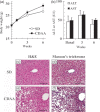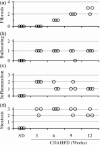An improved mouse model that rapidly develops fibrosis in non-alcoholic steatohepatitis
- PMID: 23305254
- PMCID: PMC3607137
- DOI: 10.1111/iep.12008
An improved mouse model that rapidly develops fibrosis in non-alcoholic steatohepatitis
Abstract
Non-alcoholic steatohepatitis (NASH) is a progressive fibrotic disease, the pathogenesis of which has not been fully elucidated. One of the most common models used in NASH research is a nutritional model where NASH is induced by feeding a diet deficient in both methionine and choline. However, the dietary methionine-/choline-deficient model in mice can cause severe weight loss and liver atrophy, which are not characteristics of NASH seen in human patients. Exclusive, long-term feeding with a high-fat diet (HFD) produced fatty liver and obesity in mice, but the HFD for several months did not affect fibrosis. We aimed to establish a mouse model of NASH with fibrosis by optimizing the methionine content in the HFD. Male mice were fed a choline-deficient, L-amino acid-defined, high-fat diet (CDAHFD) consisting of 60 kcal% fat and 0.1% methionine by weight. After 1-14 weeks of being fed CDAHFD, the mice were killed. C57BL/6J mice maintained or gained weight when fed CDAHFD, while A/J mice showed a steady decline in body weight (of up to 20% of initial weight). In both strains of mice, plasma levels of alanine aminotransferase increased from week 1, when hepatic steatosis was also observed. By week 6, C57BL/6J mice had developed enlarged fatty liver with fibrosis as assessed by Masson's trichrome staining and by hydroxyproline assay. Therefore, this improved CDAHFD model may be a mouse model of rapidly progressive liver fibrosis and be potentially useful for better understanding human NASH disease and in the development of efficient therapies for this condition.
Keywords: fibrosis; high-fat diet; methionine-restricted diet; mouse model; non-alcoholic steatohepatitis.
© 2013 The Authors. International Journal of Experimental Pathology © 2013 International Journal of Experimental Pathology.
Figures








References
-
- Anderson N, Borlak J. Molecular mechanisms and therapeutic targets in steatosis and steatohepatitis. Pharmacol. Rev. 2008;60:311–357. - PubMed
-
- Bellentani S, Marino M. Epidemiology and natural history of non-alcoholic fatty liver disease (NAFLD) Ann. Hepatol. 2009;8(Suppl 1):S4–S8. - PubMed
-
- Boyd JN, Graham ES, Graham TC, Tennant BC. A comparison of the response of woodchucks and rats to variations in dietary lipotrope and lipid content. J. Nutr. 1985;115:1136–1146. - PubMed
MeSH terms
Substances
LinkOut - more resources
Full Text Sources
Other Literature Sources
Medical

